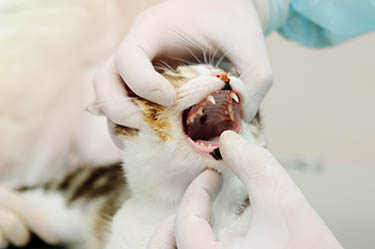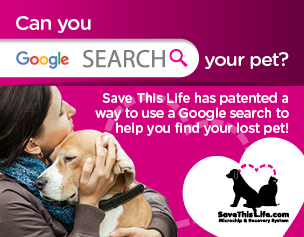Dispelling Dental Myths

Mary L. Berg, BS, RVT, RLATG, VTS (Dentistry)
Beyond the Crown Veterinary Education
Lawrence, KS
Did you know that approximately 80% of adult dogs and 70% of adult cats have some form of oral disease? Dental problems are among the top three pet owner concerns in dogs and cats. There are many misconceptions about how to provide good oral care to your patients. Here is a list of the most common myths your clients believe about their pets dental health.
1. White teeth equal a healthy mouth.
Not necessarily. The health of the gums is more important than the color of the teeth. Red swollen gums are a sign that INFECTION is lurking below the gumline. This infection can lead to bad breath, tooth loss, and heart, liver and kidney disease in pets. The best way to ensure that every pet has a healthy mouth is to perform a regular oral examination and professional tooth cleaning procedure on at least an annual basis.
2. Bad breath is normal in pets
Not true. Bad breath is an indicator of an infected mouth. The odor is often caused by the by-products of the bacteria in the mouth that form plaque and lead to dental disease. If the pet has halitosis it is time for thorough dental exam and cleaning procedure.
3. Anesthesia is scary so non-anesthetic dental cleaning is the way to go.
Yes, there is always a risk when an animal is anesthetized, however a thorough pre-op examination and blood work along with individualized anesthetic protocols and monitoring puts the pet at lesser risk during anesthesia. An anesthesia-free dental cleaning provides no benefit to the pet’s oral health. Scaling or scraping the teeth with an instrument only makes a tooth whiter in appearance. Think of the tooth an iceberg, we only see about 1/3 of the tooth with the remaining 2/3 below the gumline. The bacteria below the gumline quickly become pathologic and begin to destroy the tissues surrounding the tooth. It is not possible to eliminate bacteria beneath the gumline where damage is done. Scaling without proper polishing leaves the tooth surface roughened and will leave more surface area for bacterial plaque to attach to the tooth surface. Anesthesia-free dental cleanings are most dangerous because they give you a false sense of security that the pet has a clean mouth, leaving periodontal disease undetected and untreated. See more at: http://avdc.org/AFD/pet-periodontal-disease/#sthash.EGBX3IuT.dpuf and http://avdc.org/AFD/
4. Tooth brushing is too hard and my pet hates it and it really doesn’t help anyway.
While not all pets are willing to accept tooth brushing it is the gold standard for good oral care. It does take time to train the pet to accept tooth brushing. Make sure to have a detailed demonstration for the pet owner such as this: Start slow with your finger and some pet toothpaste. Hold the muzzle with one hand and gently insert your finger between the cheek and the teeth and “brush” the teeth. Reward the pet with his favorite treat, praise or game when he accepts the brushing! You may need to do this every day for a week to ensure your pet learns that it’s ok! Once the pet accepts your finger then begin using toothbrush, but introduce it slowly over several days. You only need to brush the outside of the teeth. Pets keep the inside of the teeth very clean on their own. Only brush the teeth you want to keep! ;-)
5. Feeding a hard kibble will keep my pets teeth clean.
False – most dogs and cats actually swallow their kibble whole therefore getting no dental benefit. Even if the pet chews the kibble, the kibble is too hard and breaks apart when the tooth hits it and offers no benefit. There are dental diets that are specifically designed to solve this problem. The kibble is larger, softer and is comprised a fiber matrix that allows the tooth to penetrate the kibble, thus wiping the plaque off the tooth.
6. Bones, chew toys and tennis balls will help keep his teeth clean.
While your dog will love you for the bone, his teeth may not. The dogs jaw does not shift side to side like a humans therefore when they chow down on a bone they often fracture the carnassial teeth. These fractured teeth hurt and can lead to infections and abscess if left untreated. A good rule of thumb when choosing a chew toy is if you can’t easily bend it with your hands or if you wouldn’t want to be hit in the knee with it, don’t give it to your pet. Wild dogs and wolves often have multiple fractures in their mouths due to chewing on bones.
Playing fetch with a tennis ball is a great way to bond with your pet but put the ball away when done. The rough surface of the tennis ball can lead to abrasion, wearing away the enamel or surface of the teeth over time. Dogs who constantly chew on tennis balls often have severely worn teeth that can lead to a very painful tooth.
7. Dogs and cats don’t feel pain!
Our pets can’t tell us about the pain they feel and they often want us to be happy so they mask the pain. An infected mouth or a fractured tooth hurt and require treatment. Pets need to eat to stay alive so they will often figure out a way to do so that causes the least amount of pain. Ask the client if they have noticed their pet dropping food or only chewing on one side of the mouth, if they have there may be a problem.
8. I don’t see the mouth so it doesn’t bother me if it’s not pretty.
Pets with dental disease have an INFECTION! Would you leave an infected ear untreated or a sore toe untreated? This infection is in the oral cavity and every time that animal chews bacteria is being released into the bloodstream. The bacteria can have a detrimental effect on the heart, liver and kidney. There are even new studies linking joint issues to the oral cavity.
9. Oral disease is an inevitable part of aging.
False – If a pet receives good oral home care and routine professional cleanings they are much less likely to develop dental disease as they age. Studies have shown that good oral care can add an average of 2 years to the life of your pet. Just as age is not a disease, dental disease does not have to be an issue in aging pets.
10. How can I know if a dental product will actually work for my pet?
The Veterinary Oral Health Council gives dental products a seal of approval for either plaque reduction or tartar reduction. The VOHC exists to recognize products that meet pre-set standards of plaque and calculus (tartar) retardation in dogs and cats. Products that are awarded the VOHC Seal of Acceptance have been proven to work based on scientific studies and protocols. www.vohc.org
References
Pavilica, Z., Petelin, M., Juntes, P, Erszen ,D., Crossley, DA, Skaleric, U, “Periodontal Disease Burden and Pathological Changes in Organs of Dogs.” J Vet Dent 2008 Jun:25(2):97-105.
DeBowes LJ: The effects of dental disease on systemic disease. Vet Clin North Am Small Anim Pract 28:1057. 1998
Debowes, LJ, Mosier, D. Association of periodontal disease and histologic lesions in multiple organs from 45 dogs. J Vet Dent 1996; 12: 57–60.
Glickman LT, Glickman NW, Moore GE, Goldstein GS, Lewis HB. Evaluation of the risk of endocarditis and other cardiovascular events on the basis of the severity of periodontal disease in dogs. JAVMA 234(4):486-494, 2009
Maresz, KJ, etal, “Prophyromonas gingivalis facilitates the development and progression of destructive arthritis through its unique bacterial peptidylarginine deiminase (PAD)” . PLos Pathog. 2013 Sep;9(9):e 1003627
Tang, Q, Fu H, Qin B, etal,”A possible link between rheumatoid arthritis and periodontitis: A systemic Review and Meta-analysis.” Int. J Periodontics Restorative Dent 2017, Jan/Feb, 37(1):79-96


Working Here
Our team members are encouraged to be the best they can be... at Covetrus we believe we impact one another.
Learn MoreNews & Events
FDA Cautions Pet Owners Not to Feed Texas Tripe Inc. Raw Pet Food Due to Salmonella, Listeria Monocytogenes
The U.S. Food and Drug Administration is cautioning pet owners not to feed their pets any of the Texas Tripe brand raw frozen pet food listed below because several samples of Texas Tripe raw pet food have tested positive for Salmonella and/or L. mono.
Careers
Are you looking for a place to let your talents shine? At Covetrus, we help our practitioner customers better serve their patients and take pride in providing the best customer experience possible. Search our open positions to see our available opportunities.
Newsletter
Stay current with what’s going on with Covetrus, subscribe to receive our newsletter and email communications. Subscribers will receive the latest information in practice management, sales and marketing, animal health, and more.



-3-(1).png?sfvrsn=2d806d73_0)

Leave a comment